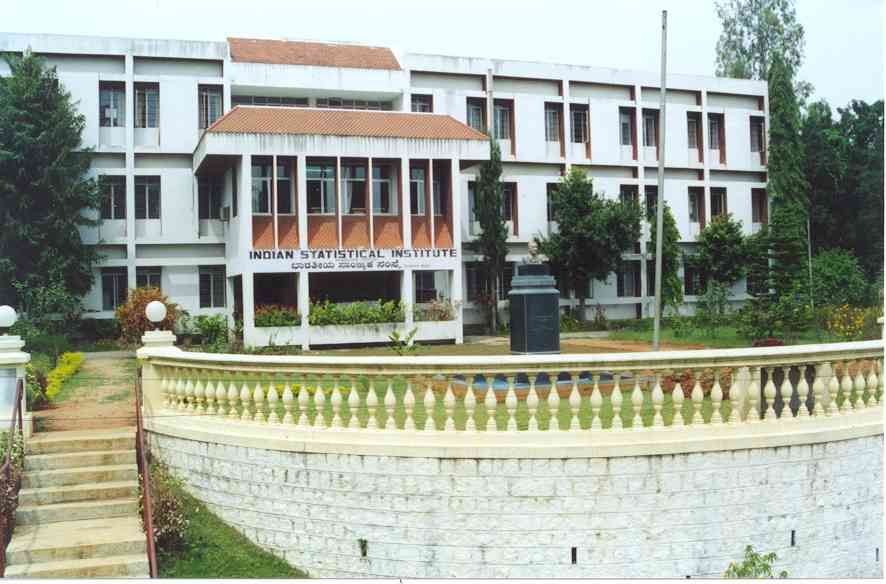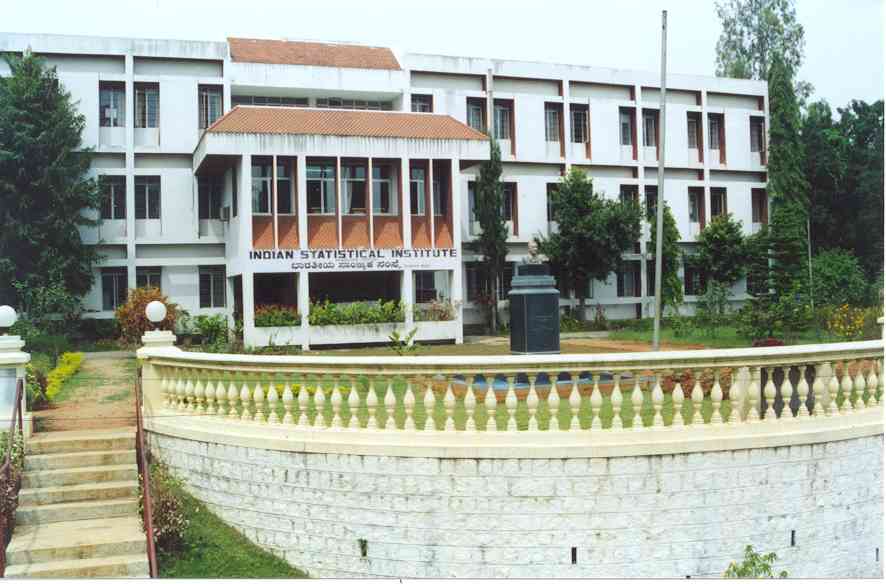 |
 |
Bangalore Probability Seminar 2012
Venue: Indian Statistical Institute (auditorium) and Indian Institute of Science (Mathematics dept)
Organizers: Siva Athreya and Manjunath Krishnapur
|

|
|
19 Nov, ISI, 2:00 PM
|
Brownian Crossings as a Regenerative process.
|
B. Rajeev (ISI, Bangalore)
|
| |
In this talk we will present a limit theorem for occupation functionals associated with the Brownian crossing process $Y_t=X_t-X_{\sigma_t}$
where ($X_t$ ) is a Brownian motion with $X_0=a$, and for an interval $(a,b)$, $\sigma_t$ is the last entrance time of ($X_t$ ) into $(a,b)$ before time $t$, i.e.
$\sigma_t = \sup\{ s \leq t : X_s \in (a,b)\}$
Our approach is to consider ($Y_t$ ) as a regenerative process with each regenerative cycle corresponding to a crossing of Brownian motion from
a to b and back to a. The crossings of Brownian motion , in turn, constitute a renewal process whose lifetime distribution is a stable random variable of index 2 ; in particular it is heavy tailed . We will show that the probabilities associated with the random variable $Y_t$ satisfy a renewal equation. This is joint work with K.B.Athreya.
|
|
19 Nov, ISI, 3:15 PM
|
Belief propagation for optimal edge-cover in the random complete graph.
|
Mustafa Khandwawala
(IISc, Bangalore)
|
| |
We apply the objective method of Aldous to the problem of finding the minimum cost edge-cover of the complete graph with random independent and identically distributed edge-costs. The limit, as the number of vertices goes to infinity, of the expected minimum cost for this problem was determined by Hessler and Wastlund using a combinatorial approach. Wastlund has also presented a different proof for this. We provide a proof of this result using the machinery of the objective method and local weak convergence. This approach was used to prove the zeta(2) limit of the random assignment problem. We further show that a belief propagation algorithm converges to the optimal solution asymptotically. Our work guides the construction of a program which can be used to solve other such optimization problems.
|
|
22 Oct, IISc, 2:00 PM
|
Risk-senstive control of continuous time Markov chains.
|
Subhamay Saha
(IISc, Mathematics)
|
| |
We study risk-sensitive control of continuous time Markov chains
taking values in discrete state space. We study both finite and infinite
horizon problems. In the finite horizon problem we characterise the value
function via HJB equation and obtain an optimal Markov control. We do the
same for infinite horizon discounted cost case. In the infinite horizon
average cost case we establish the existence of an optimal stationary
control under certain Lyapunov condition. We also develop a policy
iteration algorithm for finding an optimal control.
|
|
22 Oct, IISc, 3:15 PM
|
On some Statistical Properties of Multivariate q-Gaussian
Distribution and its application to Smoothed Functional Algorithms.
|
Debarghya Ghoshdastidar (IISc, CSA)
|
| |
The importance of the q-Gaussian distribution lies in its power-law
nature, and its close association with Gaussian, Cauchy and uniform
distributions. This distribution arises from maximization of a
generalized information measure. In this work, we study some key
properties related to higher order moments and q-moments of the
multivariate q-Gaussian distribution. Further, we present an algorithm
to generate multivariate q-Gaussian distribution.
We use these results of the q-Gaussian distribution to improve upon
the smoothing properties of Gaussian and Cauchy kernels. Based on
this, we propose a Smoothed Functional (SF) scheme for gradient and
Hessian estimation using q-Gaussian distribution. Our work extends the
class of distributions that can be used in SF algorithms by including
the q-Gaussian distributions for a range of q-values. We propose four
two-timescale algorithms for optimization of a stochastic objective
function using gradient descent and Newton based search methods. We
prove that each of the proposed algorithms converge to a local
optimum.
|
|
24 Sep, ISI, 2:15 PM
|
Covariance Estimation for Distributions with 2+\epsilon Moments.
|
Nikhil Srivastava
(Microsoft Research)
|
| |
We study the minimal sample size $N=N(n)$ that suffices to estimate the
covariance matrix of an n-dimensional distribution by the sample covariance
matrix in the operator norm, and with an arbitrary fixed accuracy. We
establish the optimal bound $N = O(n)$ for every distribution whose
k-dimensional marginals have uniformly bounded $2+\epsilon$ moments
outside the sphere of radius $O(\sqrt{k})$. In the specific case of log-concave
distributions, this result provides an alternative approach to the
Kannan-Lovasz-Simonovits problem, which was recently solved by Adamczak,
Litvak, Pajor and Tomczak-Jaegermann. Moreover, a lower estimate on the
covariance matrix holds under a weaker assumption -- uniformly bounded
$2+\epsilon$ moments of one-dimensional marginals. Our argument proceeds by
randomizing the spectral sparsification technique of Batson, Spielman and
Srivastava. The spectral edges of the sample covariance matrix are controlled
via the Stieltjes transform evaluated at carefully chosen random points.
|
|
24 Sep, ISI, 3:30 PM
|
Tree valued spatial $\Lambda$-Cannings dynamics.
|
Anita Winter (Universitat-Duisburg, Essen)
|
| |
We study the evolution of genealogies for interacting spatially structured
$\Lambda$-Cannings models which are also known as generalized Fleming-Viot
processes. These are the limit processes of individual-based population
models where individuals carry a type, and are replaced by descendants of
possibly very sizable offspring. The spatial interaction is due to migration
through geographic space.
We show that the dual to these tree-valued spatial $\Lambda$-Cannings
dynamics are tree-valued spatial $\Lambda$-coalescents, and conclude from
here the convergence of the fixed time genealogies to the genealogy of an
infinitely old population as time tends to infinity. Depending on the
strength of migration the latter consists either of a single or of multiple
families.
We then study the populations on large tori in $Z^d$ with $d\ge 2$. Depending
on the rescaling we find global features which are universal for all
$\Lambda$-Cannings dynamics and local features which heavily depend on the
measure $\Lambda$.
(This is joint work with Andreas Greven and Anton Klimovsky)
|
|
10 Sep, IISc, 2:00 PM
|
Pricing Credit Derivatives in a Markov Modulated Market.
|
Srikanth Iyer
(IISc)
|
| |
Credit risk refers to the potential losses that can arise due to
the changes in the credit quality of financial instruments. There are two
approaches to pricing credit derivatives, namely the structural and the
reduced form or intensity based models. In the structural approach
explicit assumptions are made about the dynamics of a firm's assets, its
capital structure, debt and share holders. A firm defaults when its asset
value reaches a certain lower threshold, defined endogenously within the
model. In the intensity based approach the firm's asset values and its
capital structure are not modelled at all. Instead the dynamics of default
are exogenously given through a default rate or intensity.
Some models have been studied in this regard which can
capture the feedback in case of a major credit event. We extend the
research in the same direction by proposing a new family of models
having the feedback phenomena and capturing the effects of regime
switching economy on the market. The regime switching economy is
modeled by a continuous time Markov chain. We model the default
intensity in a pool of firms using the Markov chain and a risk factor
process. We price some single-name and multi-name credit derivatives
in terms of certain transforms of the default process. We show that the
pricing formulas in our model are computationally tractable. We show that
our model can easily incorporate the effects of business cycle. We
demonstrate the impact on spreads of the inclusion of rare states that
attempt to capture a tight liquidity situation.
|
|
10 Sep, IISc, 3:15 PM
|
An asymptotic result on Skorokhod problem in an orthant.
|
S. Ramasubramanian (ISI, Bangalore)
|
|
02 Aug, ISI, 2:00 PM
|
Monte Carlo Methods for Improper Target Distributions.
|
Krishna Athreya
(Iowa State University)
|
| |
Monte Carlo methods for estimating means with respect to a proper target distribution (that is, a probability distribution) are well developed in the statistics literature. In this talk we shall present Monte Carlo methods that works for any (proper or improper) target distribution.
|
|
02 Aug, ISI, 3:15 PM
|
Large Deviation Theory of Stochastic Navier-Stokes Equations.
|
S. S. Sritharan (DRCSI, USA)
|
| |
In this talk we will discuss small noise (Wentzel-Freidlin) and large time (Donsker-Varadhan) asymptotics of Navier-Stokes equation subjected to Gaussian and Levy noise disturbances and prove large deviation principles. This type of study are important in understanding the nature of turbulence and the role of noise. Rate functions for these large deviation principles are closely connected to control theoretic type questions for the deterministic Navier-Stokes equation. Moreover, large deviation off invariant measures rely on what is currently known about ergodicity of Navier-Stokes equation. All this then naturally lead to a number of challenging open problems for exciting future research.
|
|
29 Jun, IISc, 2:00 PM
|
KPZ equation from certain microscopic interactions.
|
Sunder Sethuraman (University of Arizona)
|
| |
We derive a form of the KPZ equation, which governs the
fluctuations of a class of interface heights, in terms of a martingale
problem, as the scaling limit of fluctuation fields with respect to some
particle systems such as zero range processes. This is joint work in
progress with P. Goncalves and M. Jara.
|
|
29 Jun, IISc, 3:15 PM
|
Properties of tempered stable distributions.
|
Michael Grabchak (UNC Charlotte)
|
| |
Tempered stable distributions were introduced in Rosinski 2007 as models that look like infinite variance stable distributions in some central region, but
they have lighter (i.e. tempered) tails. We introduce a larger class of models that allow for more variety in the tails. While some cases no longer correspond to
stable distributions they serve to make the class more flexible, and in certain subclasses they have been shown to provide a good fit to data. To characterize the
possible tails we give detailed results about finiteness of various moments. We also give necessary and sufficient conditions for the tails to be regularly varying.
This last part allows us to characterize the domain of attraction to which a particular tempered stable distribution belongs. We will also characterize the weak
limits of sequences of tempered stable distributions. If time permits, we will motivate why distributions that are stable-like in some central region but with lighter
tails may show up in applications.
|
|
23 Apr, ISI, 2:15 PM
|
Probability Distributions over the Integers with Some Useful Independence Properties
|
Navin Kashyap (Indian Institute of Science)
|
| |
For an integer-valued random variable Z, let [Z] denote the binary-valued rv Z mod 2. Suppose that X, Y are iid integer-valued rvs, each having probability mass function p. It is easy to check that for non-degenerate p, the sum X+Y cannot be independent of X or Y. On the other hand, if we take any p such that Pr[[X] = 0] = 1/2, then [X+Y] is independent of each of [X] and [Y]. The question we ask is: can p be chosen such that X+Y is independent of each of [X] and [Y]? We require that Pr[[X]=0] = 1/2; the question is trivially answered otherwise. This question is motivated by a practical application: secure physical-layer function computation. We will give a general construction of p that answers our question in the affirmative. We will extend this idea to the setting of integer lattices (generalizing Z) and finite Abelian groups (generalizing [Z]). The tools used are compactly-supported characteristic functions and the Poisson summation formula. We will also describe a result of Ehm, Gneiting and Richards (Trans. AMS, 2004) that gives a complete and precise solution to the extremal problem of determining the probability distribution in R^n with characteristic function supported within the unit ball, having the least variance among such distributions.
|
|
23 Apr, ISI, 3:30 PM
|
Nodal length of random eigenfunctions of the Laplacian on the 2-d torus
|
Manjunath Krishnapur (Indian Institute of Science)
|
| |
We consider Gaussian linear combinations of eigenfunctions of the Laplacian on the 2-dimensional torus for a given eigenvalue. The mean of the length of the nodal set is easy to compute. As the dimension of the eigenspace goes to infinity, we find asymptotics of the variance of the nodal length. The proof has two main steps. First, the Kac-Rice formulas from probability give a formula for the variance in terms of the covariance kernel of the Gaussian random function. The covariance kernel is of an arithmetic nature and is analyzed using tools from additive combinatorics. This is joint work with Igor Wigman and Pär Kurlberg.
|
|
02 Apr, IISc (ECE 1.06) , 2:15 PM
|
Martingale representation theorem for Levy Processes
|
B Rajeev (Indian Statistical Institute)
|
| |
In this talk we will present a `martingale representation theorem' for square
integrable functionals of Levy processes. Our methods are based on a
`factorisation of the conditional expectation' of the finite dimensional
smooth functionals associated with the Levy process, and calculating its
derivative (Clark-Ocone Formula). We will derive a chaos expansion of the
corresponding L2 space.We present - time permitting - formulas for
calculating the integrands in the chaos expansion in terms of the given
functional.
|
|
02 Apr, IISc (ECE 1.06) , 3:30 PM
|
Brownian Motion on R-trees
|
Siva Athreya (Indian Statistical Institute)
|
| |
The real trees form a class of metric spaces that extends
the class of trees with edge lengths by allowing behavior such as infinite
total edge length and vertices with infinite branching degree. We use
Dirichlet form methods to construct Brownian motion on any given locally
compact $\mathbb R$-tree equipped with a Radon measure ν such that
supp(ν)=T. We shall discuss various properties of the
Brownian motion and recent work on approximations of the same via random
walks.
|
|
19 Mar, ISI , 2:15 PM
|
An asymptotically optimal push-pull method for multicasting over
a random network
|
Rajesh Sundaresan (Indian Institute of Science)
|
| |
The talk will be on a decentralised asymptotically optimal method for multicasting in a random edge-capacitated network. After a short introduction to the
max-flow min-cut theorem for point-to-point flows, I will describe the asymptotically optimal method for the setting when the end vertices are fixed but the number of
intermediate vertices grows and edge capacities are independent and identically distributed. I will then discuss extensions to allcast and multicast settings. Our
work may have applications for sharing and caching of files on the internet for efficient distribution and on determination of routes in videoconferencing sessions.
|
|
19 Mar, ISI, 3:30 PM
|
Joint convergence of patterned matrices and various notions of
independence
|
Koushik Saha (Indian Institute of Science)
|
| |
In this talk, we consider joint convergence of a class of patterned random matrices. It is well known that independent copies of the Wigner matrix converge, and the
limiting joint distribution satisfies freeness. We shall show that independent copies of other patterned matrices also converge, and the limits exhibit a different
type of independence. In particular, the matricial limits of symmetric circulants and reverse circulants satisfy the classical independence and the half independence,
respectively. The matricial limits of Toeplitz and Hankel matrices do not seem to submit to any easy or explicit independence/dependence notions. Their limits are not
independent, free or half independent. This talk is based on a joint work with Arup Bose and Rajat Subhra Hazra.
|
|
27 Feb, IISc (ECE, Golden jubilee hall), 2:15 PM
|
Aspects of Gromov-weak topology on the space of metric measure spaces.
|
Wolfgang Lohr (Universitat-Essen, Duisburg)
|
| |
In order to analyse random metric measure spaces (e.g. genealogical
trees), one needs a suitable topology on the space of metric measure
spaces. The Gromov-Prohorov metric on this space will be introduced and a
useful homeomorphic embedding into a space of distance matrix
distributions will be given along with some basic examples.
|
|
27 Feb, IISc (ECE, Golden jubilee hall), 3:30 PM
|
Random fields and their excursion sets: an integral geometric view.
|
Sreekar Vadlamani (TIFR-CAM, Bangalore)
|
| |
We shall consider a class of random fields defined on a smooth manifold, and study some integral geometric (global) invariants of the excursion sets of such random fields. The results we obtain bear some semblance to what are commonly known as kinematic fundamental formulae, which in turn can be looked upon as extension of Crofton formulae in the integral geometric literature.
|
|

